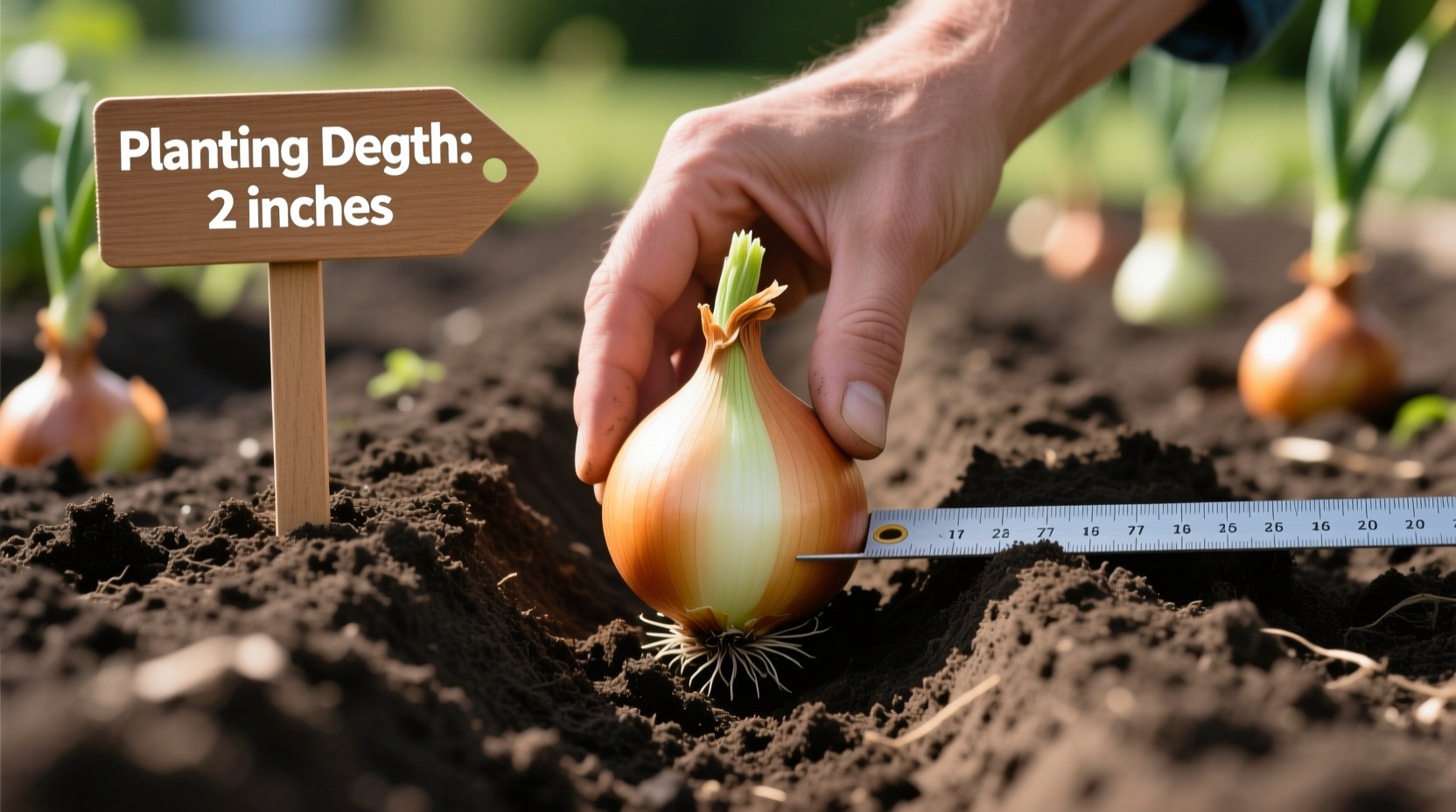
Why Planting Depth Matters for Onion Success
Getting the planting depth right for onion bulbs directly impacts your harvest quality and quantity. Planting too shallow exposes bulbs to temperature swings and drying out, while planting too deep restricts growth and delays emergence. The ideal 1-2 inch depth creates the perfect balance for root establishment and bulb development. Research from the University of Minnesota Extension confirms this depth range produces the largest, most uniform bulbs across multiple onion varieties.
Onion Planting Depth Guide by Variety
| Onion Type | Recommended Depth | Spacing Between Bulbs | Row Spacing |
|---|---|---|---|
| Yellow Storage Onions | 1-2 inches (2.5-5 cm) | 4-6 inches (10-15 cm) | 12-18 inches (30-45 cm) |
| Red Onions | 1-1.5 inches (2.5-4 cm) | 4 inches (10 cm) | 12-15 inches (30-38 cm) |
| White Onions | 1.5-2 inches (4-5 cm) | 5-6 inches (13-15 cm) | 15-18 inches (38-45 cm) |
| Green Onions (Scallions) | 0.5-1 inch (1.25-2.5 cm) | 2-3 inches (5-7.5 cm) | 10-12 inches (25-30 cm) |
Step-by-Step Onion Planting Instructions
Soil Preparation (Before Planting)
Prepare your garden bed 2-3 weeks before planting by incorporating 2-3 inches of compost into the top 6-8 inches of soil. Onions thrive in well-draining soil with a pH between 6.0-7.5. The Oregon State University Extension Service recommends conducting a soil test to determine if additional phosphorus is needed, as onions require adequate phosphorus for strong root development.
Planting Technique
- Wait until soil temperature reaches at least 50°F (10°C) before planting
- Create shallow trenches at your desired row spacing
- Place bulbs with pointed end up, flat root end down
- Space bulbs according to variety-specific recommendations
- Cover with 1-2 inches of soil (less for green onions)
- Gently firm soil over bulbs without compacting
- Water thoroughly after planting
Adjusting Depth for Different Conditions
Your exact planting depth should vary based on specific garden conditions. In heavier clay soils, plant slightly shallower (1 inch) to prevent bulbs from sitting in moisture too long. In sandy soils that dry out quickly, plant toward the deeper end (2 inches) to maintain consistent moisture around developing roots. During unusually cold springs, adding an extra half inch of soil provides additional insulation for emerging shoots.
Onion Growth Timeline: What to Expect After Planting
Understanding the growth stages helps you identify potential problems early:
- Days 1-7: Roots begin developing downward while the shoot pushes upward
- Days 7-14: First green shoots emerge from soil surface
- Weeks 3-6: Active leaf growth with minimal bulb development
- Weeks 7-12: Bulb formation begins as days lengthen
- Weeks 12-16: Bulb swelling phase with rapid growth
- Weeks 16-20: Maturation phase when tops begin falling over
Common Planting Mistakes That Reduce Your Harvest
Gardeners frequently make these errors when planting onion bulbs:
- Planting too deep: Bulbs struggle to emerge, resulting in weak plants and smaller yields
- Planting upside down: Roots grow upward while shoots grow downward, wasting energy
- Insufficient spacing: Crowded bulbs compete for nutrients, producing undersized onions
- Planting too early: Cold soil temperatures cause bulbs to bolt (produce flowers)
- Ignoring soil preparation: Poor drainage leads to rot, while nutrient-deficient soil limits growth
Troubleshooting Poor Onion Growth
If your onions aren't performing as expected, check these common issues:
- Yellowing leaves: Could indicate planting too deep or nitrogen deficiency
- Small bulbs: Often caused by overcrowding, poor soil fertility, or incorrect day-length varieties
- Bolting (flowering): Usually happens when exposed to extended cold after planting
- Rotting bulbs: Typically results from heavy, poorly draining soil or excessive moisture
Harvesting and Storage Tips
Harvest onions when tops naturally fall over and begin drying. Cure bulbs in a warm, dry, well-ventilated area for 2-3 weeks before storage. Store cured onions in mesh bags or crates in a cool (32-45°F), dark, dry location with good air circulation. Properly stored onions can last 4-6 months depending on variety.











 浙公网安备
33010002000092号
浙公网安备
33010002000092号 浙B2-20120091-4
浙B2-20120091-4